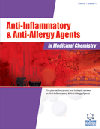- Home
- A-Z Publications
- Anti-Inflammatory & Anti-Allergy Agents in Medicinal Chemistry (Formerly Current Medicinal Chemistry - Anti-Inflammatory and Anti-Allergy Agents)
- Previous Issues
- Volume 15, Issue 2, 2016
Anti-Inflammatory & Anti-Allergy Agents in Medicinal Chemistry (Formerly Current Medicinal Chemistry - Anti-Inflammatory and Anti-Allergy Agents) - Volume 15, Issue 2, 2016
Volume 15, Issue 2, 2016
-
-
Anti-inflammatory Action of Green Tea
More LessAuthors: Tomokazu Ohishi, Shingo Goto, Pervin Monira, Mamoru Isemura and Yoriyuki NakamuraBackground: Green tea has been shown to have beneficial effects against a variety of diseases such as cancer, obesity, diabetes, cardiovascular disease, and neurodegenerative diseases. Through cellular, animal, and human experiments, green tea and its major component, epigallocatechin-3-gallate (EGCG) have been demonstrated to have anti-inflammatory effects. Our previous findings have indicated that green tea and E Read More
-
-
-
Hypersensitivity Reactions from Excipients in Systemic Glucocorticoid Formulations
More LessAuthors: Gianfranco Calogiuri, Lene H. Garvey, Paolo Romita, Luigi Macchia and Caterina FotiGlucocorticoids are the most widely used drugs for the treatment of hypersensitivity, however these drugs themselves and the excipients contained in commercial corticosteroid formulations are able to induce severe immediate-type hypersensitivity reactions. Reactions involving excipients have been confirmed to be IgE mediated by the demonstration of specific-IgE to excipients such as carboxymethylcellulose and lactose. In ca Read More
-
-
-
Colon Targeted Rifaximin Nanosuspension for the Treatment of Inflammatory Bowel Disease (IBD)
More LessAuthors: Jatinder Kumar and AMJ NewtonBackground: Although, a number of formulations have been developed for the treatment of IBD yet the developed formulations are having side effects such as high dose, lack of solubility and permeability problems at the site of action. Very few formulations have been developed for the IBD treatment in the form of nanoparticles. Nanoparticles have shown their potential in the recent findings in the treatment of IBD at cellula Read More
-
-
-
Synthesis and Pharmacological Evaluation of Tetrazolobenzimidazoles as Novel Anti-inflammatory Agents
More LessAuthors: Mayura A. Kale, Rajesh B. Nawale, Manjiri R. Peharkar and Sharad V. KuberkarBackground: Currently used anti-inflammatory drugs are associated with some severe side effects such as gastric irritation, which may range from simple discomfort to ulcer formation. Therefore, the development of potent anti-inflammatory drugs with fewer side effects is important. Benzimidazole, tetrazole and its various derivatives have been used in the synthesis of numerous heterocyclic compounds. In the past fe Read More
-
-
-
Synthesis and Biological Evaluation of New N-(4-Substituted phenyl)glycine Derivatives as Potential Anti-inflammatory Agents
More LessAuthors: Waleed A. Bayoumi, Mariam A. Ghaly and Mohamed E. ShakerBackground: Designing new anti-inflammatory agents possessing safe therapeutic profiles and devoid of potential undesirable side effects is an active field in medicinal chemistry. Thus, a series of N-(4-substituted phenyl)glycine derivatives was designed and synthesized. The idea behind the design is to utilize the bifunctionality of 4-aminoacetophenone via converting the amino group into glycine derivative as a side arm to mi Read More
-
-
-
Reduction of eNOS in Vascular Smooth Muscle by Salt Independently of Hypertension
More LessBackground: Endothelial nitric oxide synthase (eNOS) is known to be expressed in endothelium and smooth muscle cells of arteries. The aim of this study was to investigate the expression of eNOS in intimal and medial layer of aorta from rats fed with a high salt diet and its modulation by losartan and tempol. Methods: Rats were fed during three weeks with: normal salt diet (NS, 0.4% NaCl); high salt diet (HS, 8% NaCl); NS Read More
-
-
-
Pharmacological Evaluation of Antiasthmatic Activity of Myrica nagi Bark Extracts
More LessAuthors: Rinu K. Rana and Rakesh K. PatelBackground: The involvement of debilitating side effects of allopathic antiasthmatic drugs provides a strong impetus for the development of new herbal therapeutics. Myrica nagi Thunb. (Syn. Kaiphal) of Myricaceae family is a known drug of the Ayurveda system used for the treatment of several diseases including asthma. Methods: The present study deals with the preparation and phytochemical screening of polar, non-po Read More
-
Volumes & issues
-
Volume 24 (2025)
-
Volume 23 (2024)
-
Volume 22 (2023)
-
Volume 21 (2022)
-
Volume 20 (2021)
-
Volume 19 (2020)
-
Volume 18 (2019)
-
Volume 17 (2018)
-
Volume 16 (2017)
-
Volume 15 (2016)
-
Volume 14 (2015)
-
Volume 13 (2014)
-
Volume 12 (2013)
-
Volume 11 (2012)
-
Volume 10 (2011)
-
Volume 9 (2010)
-
Volume 8 (2009)
-
Volume 7 (2008)
-
Volume 6 (2007)
-
Volume 5 (2006)
Most Read This Month
Article
content/journals/aiaamc
Journal
10
5
false
en


